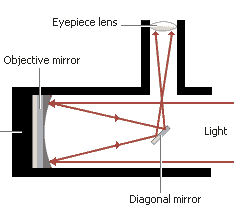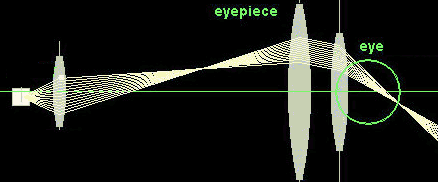Optical instruments
The Magnifying Glass and Angular Magnification
 To make the image of a small object on the retina as large as possible, you
must move the object as close to your eye as accommodation allows. A magnifying glass enables you to enlarge the image on your retina even
further. If you position the object less than or equal to one focal length fmag
away from the magnifying glass, and if the glass is positioned close to your
eye, a magnified virtual image is formed (at least 25 cm from your eye). The eye
forms a magnified real image of this enlarged virtual image on the retina.
To make the image of a small object on the retina as large as possible, you
must move the object as close to your eye as accommodation allows. A magnifying glass enables you to enlarge the image on your retina even
further. If you position the object less than or equal to one focal length fmag
away from the magnifying glass, and if the glass is positioned close to your
eye, a magnified virtual image is formed (at least 25 cm from your eye). The eye
forms a magnified real image of this enlarged virtual image on the retina.
We define the angular magnification mα
as the angle subtended by the virtual image (αi)
divided by the angle subtended by the object when viewed with the unaided eye (αu).
mα = αi/αu
Here αi
and αu
are the angles made by the chief rays from the edge of the object with the optic
axis in the case of the aided and unaided eye, respectively. The chief ray is
the ray that passes through the center of the pupil.
A label such as
"2X" or "10X" printed on a magnifying glass or an eyepiece belonging to a
microscope or telescope indicates the angular magnification mα
when the object is positioned at the focal length fmag of the
magnifying glass, such that the virtual image is infinitely far away.
This is
called the magnifying power MP.
MP = (25 cm)/fmag.
 Example:
Example:
In the figure on the right h(o) denote the height of the object and s the diameter
of the eyeball.
If the object is a distance of 25 cm from the eye, then the
tangent of the angle made by the chief ray from the top of the object is
tanθu=
h(o)/25.
 With the object positioned at the focal length fmag
of the magnifying glass, the tangent of the angle made by the chief ray is
With the object positioned at the focal length fmag
of the magnifying glass, the tangent of the angle made by the chief ray is
tanθi
= h(o)/fmag.
(Rays coming from a point in the object focal plane of a lens
emerge as parallel rays from the other side of the lens.
A ray entering parallel
to the optic axis is deflected through the image focus.)
This yields in the small angle approximation
MP = θi/θu
= 25 cm/fmag.
Placement of an object at the focal point of a magnifier or eyepiece is the ideal way to use these instruments, since the rays from the virtual image entering the eye are then parallel, and thus no accommodation is required to view the image on the retina.

A magnifying glass is an optical instrument consisting of a single lens and the eye. Other single lens optical instrument are a simple camera and a slide projector.


Keplerian telescope

Galilean telescope
Telescopes
A basic refracting telescope is an optical instrument that has two optical
elements, an objective and an eyepiece. We have two thin lenses in air. The
objective is a large lens that collects light from a distant object and creates
an image in the focal plane, which is a faithful representation of the object. The eyepiece is a sophisticated magnifying glass through which we view this
image.
A Keplerian telescope has a converging lens eyepiece and a Galilean telescope
has a diverging lens eyepiece. The distance between the image and the eyepiece
is the sum of the focal lengths of the two lenses. (Remember that for a
diverging lens the focal length is negative.) A telescope by itself is not an
image forming system. The eye of the observer or the camera attached to the
telescope forms the image.
We use a telescope to gather light and to increase the angle that a distant
object subtends at the eye. The amount of light a telescope can gather increases
with the square of the diameter of the objective. So a telescope with a 10 inch
objective gathers 4 times as much light from a faint, distant source than a
telescope with a 5 inch objective.
If the eye is relaxed for distant viewing, the telescope simply produces an
angular magnification equal to the ratio of the focal length of the objective to
the focal length of the eyepiece, Mθ = -fo/fe. An incident (approximately) parallel beam from a distant source point, which
makes an angle θ with respect to the optical axis,
emerges as a parallel beam which makes a larger angle θ'
= -(fo/fe)θ with respect to the axis. If Mθ
is negative, a viewer will see an inverted image.

(a)

(b)
A Keplerian (a) and a Galilean (b) telescope with the same angular magnification.

Newtonian Reflecting Telescope
There are two basic types of telescopes:
- A refractor telescope that uses a large lens to gather light.
- A reflector telescope that uses a large mirror to gather light.
External link:
Telescope ray tracing app
Explore the angular magnification by dragging rays.
Problem:
You want to build a Galilean telescope. You have two convex lenses and two concave lenses available. The larger lenses have focal lengths +80 cm and -80 cm respectively and the smaller lenses have focal lengths +20 cm and - 20 cm respectively. Which lenses should you use and how far apart should you place them
Solution:
- Reasoning:
A Galilean telescope has a diverging lens eyepiece. - Details of the calculation:
Use the f = -20 cm lens and the f = 80 cm lens. Place the lenses 60 cm apart.
Microscopes
A compound microscope uses a simple combination of two converging lenses to produce a very effective magnifier. A sketch is shown below. The lens closest to the object is known as the objective, and the second lens is the eyepiece. The object is placed between fo and 2fo. An intermediate real image is formed by the objective lens near the object focal plane of the eyepiece. The tube length g is the distance between the secondary focal point of the objective and the primary focal point of the eyepiece. The intermediate image serves as the object for the eyepiece.

The total angular magnification or magnifying power of the microscope is given by MP = -(g/fo)MPeyepiece. A label such as "2X" or "10X" printed on the eyepiece belonging to a microscope or telescope indicates the angular magnification when the real image of the object is positioned at the focal length fe of the eyepiece, such that the virtual image is infinitely far away. MPeyepiece is given by MPeyepiece = (25 cm)/fe. The relaxed normal eye can then form an image on the retina. The focal lengths of both lenses should be extremely short to generate maximum angular magnification.



Illustration of the angular magnification of a microscope
For more information, explore the anatomy of a microscope!